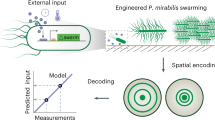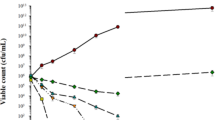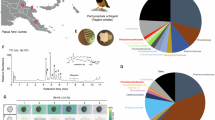Abstract
Flies transport specific bacteria with their larvae that provide a wider range of nutrients for those bacteria. Our hypothesis was that this symbiotic interaction may depend on interkingdom signaling. We obtained Proteus mirabilis from the salivary glands of the blow fly Lucilia sericata; this strain swarmed significantly and produced a strong odor that attracts blow flies. To identify the putative interkingdom signals for the bacterium and flies, we reasoned that as swarming is used by this bacterium to cover the food resource and requires bacterial signaling, the same bacterial signals used for swarming may be used to communicate with blow flies. Using transposon mutagenesis, we identified six novel genes for swarming (ureR, fis, hybG, zapB, fadE and PROSTU_03490), then, confirming our hypothesis, we discovered that fly attractants, lactic acid, phenol, NaOH, KOH and ammonia, restore swarming for cells with the swarming mutations. Hence, compounds produced by the bacterium that attract flies also are utilized for swarming. In addition, bacteria with the swarming mutation rfaL attracted fewer blow flies and reduced the number of eggs laid by the flies. Therefore, we have identified several interkingdom signals between P. mirabilis and blow flies.
Similar content being viewed by others
Log in or create a free account to read this content
Gain free access to this article, as well as selected content from this journal and more on nature.com
or
References
Abeyrathne PD, Lam JS . (2007). WaaL of Pseudomonas aeruginosa utilizes ATP in in vitro ligation of O antigen onto lipid A-core. Mol Microbiol 65: 1345–1359.
Ahmad A, Broce A, Zurek L . (2006). Evaluation of significance of bacteria in larval development of Cochliomyia macellaria (Diptera: Calliphoridae). J Med Entomol 43: 1129–1133.
Anagnostou C, Dorsch M, Rohlfs M . (2010). Influence of dietary yeasts on Drosophila melanogaster life-history traits. Entomol Exp Appl 136: 1–11.
Atlas RM . (2004). Handbook of Microbiological Media. CRC Press: London.
Baba T, Ara T, Hasegawa M, Takai Y, Okumura Y, Baba M et al. (2006). Construction of Escherichia coli K-12 in-frame, single-gene knockout mutants: the Keio collection. Mol Syst Biol 2: 2006 0008.
Bansal T, Alaniz RC, Wood TK, Jayaraman A . (2010). The bacterial signal indole increases epithelial-cell tight-junction resistance and attenuates indicators of inflammation. Proc Natl Acad Sci USA 107: 228–233.
Barker JSF . (1992). Genetic variation in cactophilic Drosophila for oviposition on natural yeast substrates. Evolution 46: 1070–1083.
Belas R, Goldman M, Ashliman K . (1995). Genetic analysis of Proteus mirabilis mutants defective in swarmer cell elongation. J Bacteriol 177: 823–828.
Bernier UR, Kline DL, Barnard DR, Schreck CE, Yost RA . (2000). Analysis of human skin emanations by gas chromatography/mass spectrometry.2. Identification of volatile compounds that are candidate attractants for the yellow fever mosquito (Aedes aegypti). Anal Chem 72: 747–756.
Broce AB . (1980). Sexual behavior of screwworm flies stimulated by swormlure-2. Ann Entomol Soc Amer 73: 386–389.
Campbell 3rd PW, Phillips 3rd JA, Heidecker GJ, Krishnamani MR, Zahorchak R, Stull TL . (1995). Detection of Pseudomonas (Burkholderia) cepacia using PCR. Pediatr Pulmonol 20: 44–49.
Chaudhury MF, Skoda SR, Sagel A, Welch JB . (2010). Volatiles emitted from eight wound-isolated bacteria differentially attract gravid screwworms (Diptera: Calliphoridae) to oviposit. J Med Entomol 47: 349–354.
Chaudhury MF, Welch JB, Alvarez LA . (2002). Response of fertile and sterile screwworm (Diptera: Calliphoridae) flies to bovine blood inoculated with bacteria originating from screwworm infested animal wounds. J Med Entomol 39: 130–134.
Clark K, Evans L, Wall R . (2006). Growth rates of the blowfly, Lucilia sericata, on different body tissues. Forensic Sci Int 156: 145–149.
Clemmer KM, Rather PN . (2007). Regulation of flhDC expression in Proteus mirabilis. Res Microbiol 158: 295–302.
Cragg JB . (1950). The reactions of Lucilia sericata (Mg.) to various substances placed on sheep. Parasitology 40: 179–186.
Daniels R, Vanderleyden J, Michiels J . (2004). Quorum sensing and swarming migration in bacteria. FEMS Microbiol Rev 28: 261–289.
Davies DG, Parsek MR, Pearson JP, Iglewski BH, Costerton JW, Greenberg EP . (1998). The involvement of cell-to-cell signals in the development of a bacterial biofilm. Science 280: 295–298.
Dethier VG . (1947). Chemical Insect Attractants and Repellents. The Blakiston Company: Philadelphia.
Domka J, Lee J, Wood TK . (2006). YliH (BssR) and YceP (BssS) regulate Escherichia coli K-12 biofilm formation by influencing cell signaling. Appl Environ Microbiol 72: 2449–2459.
Easton C, Feir D . (1991). Factors affecting the oviposition of Phaenicia sericata (Meigen) (Diptera: Calliphoridae). J Kans Entomol Soc 64: 287–294.
Eisemann CH . (1988). Upwind flight by gravid Australian sheep blowflies, Lucilia cuprina (Wiedemann) (Diptera: Calliphoridae), in response to stimuli from sheep. Bull Entomol Res 78: 273–279.
Eisemann CH, Rice MJ . (1987). The origin of sheep blowfly, Lucilia cuprina (Wiedemann) (Diptera: Calliphoridae), attractants in media infested with larvae. Bull Entomol Res 77: 287–294.
Erdmann GR . (1987). Antibacterial action of myiasis-causing flies. Parasitol Today 3: 214–216.
Ewing AW, Manning A . (1967). The evolution and genetics of insect behaviour. Annu Rev Entomol 12: 471–494.
Felton GW, Tumlinson JH . (2008). Plant-insect dialogs: complex interactions at the plant-insect interface. Curr Opin Plant Biol 11: 457–463.
FoodNet, June 2006. CDC FoodNet Surveillance Report for 2004.
Fraser GM, Bennett JC, Hughes C . (1999). Substrate-specific binding of hook-associated proteins by FlgN and FliT, putative chaperones for flagellum assembly. Mol Microbiol 32: 569–580.
González Barrios AF, Zuo R, Hashimoto Y, Yang L, Bentley WE, Wood TK . (2006). Autoinducer 2 controls biofilm formation in Escherichia coli through a novel motility quorum-sensing regulator (MqsR, B3022). J Bacteriol 188: 305–316.
Gram L, Nys Rd, Maximilien R, Givskov M, Steinberg P, Kjelleberg S . (1996). Inhibitory effects of secondary metabolites from the red alga Delisea pulchra on swarming motility of Proteus mirabilis. Appl Environ Microbiol 62: 4284–4287.
Greenberg B . (1973). Biology and Disease Transmission Vol 2. Princeton University Press: Princeton, New Jersey.
Han TH, Lee JH, Cho MH, Wood TK, Lee J . (2010). Environmental factors affecting indole production in Escherichia coli. Res Microbiol 162: 108–116.
Hepburn GA, Nolte MCA . (1943). Sheep blowfly research III. studies on the olfactory reactions of sheep blowflies. Onderstepoort J Vet Res 18: 27–48.
Hilker M, Meiners T . (2002). Chemoecology of Insect Eggs and Egg Decomposition. Blackwell Publishing Company: Berlin.
Hughes DT, Sperandio V . (2008). Inter-kingdom signalling: communication between bacteria and their hosts. Nat Rev Microbiol 6: 111–120.
Izard D, Husson MO, Vincent P, Leclerc H, Monget D, Boeufgras JM . (1984). Evaluation of the four-hour rapid 20E system for identification of members of the family Enterobacteriaceae. J Clin Microbiol 20: 51–54.
Janda JM, Abbott SL . (2005). The Enterobacteria. ASM press: Washington, DC.
Jayaraman A, Wood TK . (2008). Bacterial quorum sensing: signals, circuits, and implications for biofilms and disease. Annu Rev Biomed Eng 10: 145–167.
Juárez Tomás MS, Ocaña VS, Wiese B, Nader-Macías ME . (2003). Growth and lactic acid production by vaginal Lactobacillus acidophilus CRL 1259, and inhibition of uropathogenic Escherichia coli. J Med Microbiol 52: 1117–1124.
Kobayashi D, Sakata T . (2006). Influence of temperature on short-chain fatty acid production by pig cecal bacteria in vitro. J Nutr Sci Vitaminol 52: 66–69.
Lazzaro BP . (2005). Elevated polymorphism and divergence in the class C scavenger receptors of Drosophila melanogaster and D. simulans. Genetics 169: 2023–2034.
Lazzaro BP, Clark AG . (2001). Evidence for recurrent paralogous gene conversion and exceptional allelic divergence in the attacin genes of Drosophila melanogaster. Genetics 159: 659–671.
Lazzaro BP, Sceurman BK, Clark AG . (2004). Genetic basis of natural variation in D. melanogaster antibacterial immunity. Science 303: 1873–1876.
Lee J, Attila C, Cirillo SL, Cirillo JD, Wood TK . (2009). Indole and 7-hydroxyindole diminish Pseudomonas aeruginosa virulence. Microb Biotechnol 2: 75–90.
Lee J, Bansal T, Jayaraman A, Bentley WE, Wood TK . (2007). Enterohemorrhagic Escherichia coli biofilms are inhibited by 7-hydroxyindole and stimulated by isatin. Appl Environ Microbiol 73: 4100–4109.
Liaw SJ, Lai HC, Ho SW, Luh KT, Wang WB . (2001). Characterisation of p-nitrophenylglycerol-resistant Proteus mirabilis super-swarming mutants. J Med Microbiol 50: 1039–1048.
Liberati NT, Urbach JM, Miyata S, Lee DG, Drenkard E, Wu G et al. (2006). An ordered, nonredundant library of Pseudomonas aeruginosa strain PA14 transposon insertion mutants. Proc Natl Acad Sci USA 103: 2833–2838.
Liu D . (2010). Molecular Detection of Foodborne Pathogens. CRC Press: Boca Raton.
Mackay TF . (2010). Mutations and quantitative genetic variation: lessons from Drosophila. Philos Trans R Soc Lond B Biol Sci 365: 1229–1239.
Margolies DC, Sabelis MW, Boyer JE . (1997). Response of a phytoseiid predator to herbivore-induced plant volatiles: selection on attraction and effect on prey exploitation. J Insect Behav 10: 695–709.
Miller MB, Bassler BL . (2001). Quorum sensing in bacteria. Annu Rev Microbiol 55: 165–199.
Miller PM, Saltz JB, Cochrane VA, Marcinkowski CM, Mobin R, Turner TL . (2011). Natural variation in decision-making behavior in Drosophila melanogaster. PLoS One 6: e16436.
Miller WJ, Ehrman L, Schneider D . (2010). Infectious speciation revisited: impact of symbiont-depletion on female fitness and mating behavior of Drosophila paulistorum. PLoS Pathog 6: e1001214.
Mobley HL, Belas R . (1995). Swarming and pathogenicity of Proteus mirabilis in the urinary tract. Trends Microbiol 3: 280–284.
Moreno LI, Mills D, Fetscher J, John-Williams K, Meadows-Jantz L, McCord B . (2011). The application of amplicon length heterogeneity PCR (LH-PCR) for monitoring the dynamics of soil microbial communities associated with cadaver decomposition. J Microbiol Methods 84: 388–393.
Morgenstein RM, Clemmer KM, Rather PN . (2010). Loss of the WaaL O-antigen ligase prevents surface activation of the flagellar gene cascade in Proteus mirabilis. J Bacteriol 192: 3213–3221.
Morris MC . (2005). Tests on a new bait for flies (Diptera: Calliphoridae) causing cutaneous myiasis (flystrike) in sheep. New Zeal J Agr Res 48: 151–156.
Mulla MS, Axelrod H, Hwang Y-S . (1984). Field evaluation of chemical attractants against the fly Fannia femoralis. J Chem Ecol 10: 349–360.
Nicholson EB, Concaugh EA, Foxall PA, Island MD, Mobley HL . (1993). Proteus mirabilis urease: transcriptional regulation by UreR. J Bacteriol 175: 465–473.
Paine TD, Raffa KF, Harrigton TC . (1997). Interactions among scolytid bark beetles, their associated fungi, and live host conifers. Annu Rev Entomol 42: 179–206.
Panteleev DY, Goryacheva II, Andrianov BV, Reznik NL, Lazebny OE, Kulikov AM . (2007). The endosymbiotic bacterium Wolbachia enhances the nonspecific resistance to insect pathogens and alters behavior of Drosophila melanogaster. Russ J Genet 43: 1066–1069.
Patel NJ, Zaborina O, Wu L, Wang Y, Wolfgeher DJ, Valuckaite V et al. (2007). Recognition of intestinal epithelial HIF-1α activation by Pseudomonas aeruginosa. Am J Physiol Gastrointest Liver Physiol 292: G134–G142.
Pelletier J, Hughes DT, Luetje CW, Leal WS . (2010). An odorant receptor from the southern house mosquito Culex pipiens quinquefasciatus sensitive to oviposition attractants. PLoS One 5: e10090.
Ponnusamy L, Xu N, Nojima S, Wesson DM, Schal C, Apperson CS . (2008). Identification of bacteria and bacteria-associated chemical cues that mediate oviposition site preferences by Aedes aegypti. Proc Natl Acad Sci USA 105: 9262–9267.
Poonam S, Paily KP, Balaraman K . (2002). Oviposition attractancy of bacterial culture filtrates- response of Culex quinquefasciatus. Mem Inst Oswaldo Cruz 97: 359–362.
Ren D, Sims JJ, Wood TK . (2001). Inhibition of biofilm formation and swarming of Escherichia coli by (5Z)-4-bromo-5-(bromomethylene)-3-butyl-2(5H)-furanone. Environ Microbiol 3: 731–736.
Richardson OH . (1916). A chemotropic response of the house fly (Musca domestica L). Science 43: 613–616.
Robacker DC . (2001). Roles of putrescine and 1-pyrroline in attractiveness of technical-grade putrescine to the Mexican fruit fly (Diptera: Tephritidae). Fla Entomol 84: 679–685.
Rollmann SM, Wang P, Date P, West SA, Mackay TF, Anholt RR . (2010). Odorant receptor polymorphisms and natural variation in olfactory behavior in Drosophila melanogaster. Genetics 186: 687–697.
Sambandan D, Carbone MA, Anholt RR, Mackay TF . (2008). Phenotypic plasticity and genotype by environment interaction for olfactory behavior in Drosophila melanogaster. Genetics 179: 1079–1088.
Sanderson MW, Sargeant JM, Shi X, Nagaraja TG, Zurek L, Alam MJ . (2006). Longitudinal emergence and distribution of Escherichia coli O157 genotypes in a beef feedlot. Appl Environ Microbiol 72: 7614–7619.
Schmidtchen A, Wolff H, Rydengard V, Hansson C . (2003). Detection of serine proteases secreted by Lucilia sericata in vitro and during treatment of a chronic leg ulcer. Acta Derm Venereol 83: 310–311.
Sharon G, Segal D, Ringo JM, Hefetz A, Zilber-Rosenberg I, Rosenberg E . (2010). Commensal bacteria play a role in mating preference of Drosophila melanogaster. Proc Natl Acad Sci USA 107: 20051–20056.
Smith CN, Smith N, Gouck HK, Weidhaas DE, Gilbert IH, Mayer MS et al. (1970). L-lactic acid as a factor in the attraction of Aedes aegypti (Diptera: Culicidae) to human hosts. Ann Entomol Soc Am 63: 760–770.
Sokal RR, Rohlf FJ . (1995). Biometry: The Principles and Practice of Statistics in Biological Research. W. H. Freeman and Co.: New York.
Stephen FM, Berisford CW, Dahlsten DL, Fenn P, Moser JC . (1993). Invertebrate and microbial associates. In: Schowalter TD, Filip GM (eds). Beetle-Pathogen Interactions in Conifer Forests. Academic Press: San Diego, pp 129–153.
Stevenson LG, Rather PN . (2006). A novel gene involved in regulating the flagellar gene cascade in Proteus mirabilis. J Bacteriol 188: 7830–7839.
Sturgill G, Rather PN . (2004). Evidence that putrescine acts as an extracellular signal required for swarming in Proteus mirabilis. Mol Microbiol 51: 437–446.
Tarone AM, Picard CJ, Spiegelman C, Foran DR . (2011). Population and temperature effects on Lucilia sericata (Diptera: Calliphoridae) body size and minimum development Time. J Med Entomol 48: 1062–1068.
Tessmer JW, Meek CL, Wright VL . (1995). Circadian patterns of oviposition by necrophilous flies (Diptera: Calliphoridae) in southern Louisiana. Southwest Entomol 20: 439–445.
Thomas DB . (1991). Time-activity budget of adult screwworm behavior (Diptera: Calliphoridae). J Med Entomol 28: 372–377.
Ueda A, Wood TK . (2009). Connecting quorum sensing, c-di-GMP, pel polysaccharide, and biofilm formation in Pseudomonas aeruginosa through tyrosine phosphatase TpbA (PA3885). PLoS Pathog 5: e1000483.
Updegraff DM . (1949). The production of phenol and para-cresol by marine bacteria. J Bacteriol 57: 555–564.
Urech R, Green PE, Rice MJ, Brown GW, Duncalfe F, Webb P . (2004). Composition of chemical attractants affects trap catches of the Australian sheep blowfly, Lucilia cuprina, and other blowflies. J Chem Ecol 30: 851–866.
Vacek DC, East PD, Barker JSF, Soliman MH . (1985). Feeding and oviposition preferences of Drosophila buzzatii for microbial species isolated from its natural environment. Biol J Linn Soc 24: 175–187.
Vince A, Dawson AM, Park N, O’Grady F . (1973). Ammonia production by intestinal bacteria. Gut 14: 171–177.
Walker KE, Moghaddame-Jafari S, Lockatell CV, Johnson D, Belas R . (1999). ZapA, the IgA-degrading metalloprotease of Proteus mirabilis, is a virulence factor expressed specifically in swarmer cells. Mol Microbiol 32: 825–836.
Wardle RA . (1921). The protection of meat commodities against blowflies. Ann Appl Biol 8: 1–9.
Waters CM, Bassler BL . (2005). Quorum sensing: cell-to-cell communication in bacteria. Annu Rev Cell Dev Biol 21: 319–346.
Wiwatanaratanabutr I, Allan S, Linthicum K, Kittayapong P . (2010). Strain-specific differences in mating, oviposition, and host-seeking behavior between Wolbachia-infected and uninfected Aedes albopictus. J Am Mosq Control Assoc 26: 265–273.
Wu L, Estrada O, Zaborina O, Bains M, Shen L, Kohler JE et al. (2005). Recognition of host immune activation by Pseudomonas aeruginosa. Science 309: 774–777.
Yokoyama MT, Carlson JR . (1981). Production of skatole and para-cresol by a rumen Lactobacillus sp. Appl Environ Microbiol 41: 71–76.
Acknowledgements
We are grateful for the Keio and ASKA strains provided by the Genome Analysis Project in Japan. This work was supported by the NIH (R01 GM089999), Texas AgriLife Research and the Texas A & M University College of Agriculture and Life Sciences. TKW is the T Michael O’Connor Endowed Professor at Texas A & M University.
Author information
Authors and Affiliations
Corresponding authors
Additional information
Supplementary Information accompanies the paper on The ISME Journal website
Supplementary information
Rights and permissions
About this article
Cite this article
Ma, Q., Fonseca, A., Liu, W. et al. Proteus mirabilis interkingdom swarming signals attract blow flies. ISME J 6, 1356–1366 (2012). https://doi.org/10.1038/ismej.2011.210
Received:
Revised:
Accepted:
Published:
Issue date:
DOI: https://doi.org/10.1038/ismej.2011.210
Keywords
This article is cited by
-
Characterization of the microbiome and volatile compounds in anal gland secretions from domestic cats (Felis catus) using metagenomics and metabolomics
Scientific Reports (2023)
-
Potential use of molecular and structural characterization of the gut bacterial community for postmortem interval estimation in Sprague Dawley rats
Scientific Reports (2021)
-
Microbiome pattern of Lucilia sericata (Meigen) (Diptera: Calliphoridae) and feeding substrate in the presence of the foodborne pathogen Salmonella enterica
Scientific Reports (2021)
-
Volatile organic compounds in variably aged carrion impacted by the presence of the primary colonizer, Cochliomyia macellaria (Diptera: Calliphoridae)
International Journal of Legal Medicine (2021)
-
Bacterial association observations in Lucilia sericata and Lucilia cuprina organs through 16S rRNA gene sequencing
Applied Microbiology and Biotechnology (2021)



